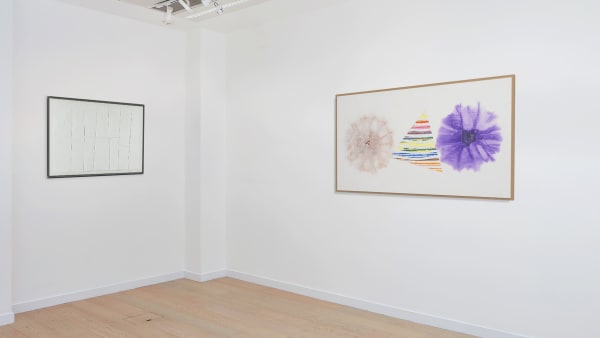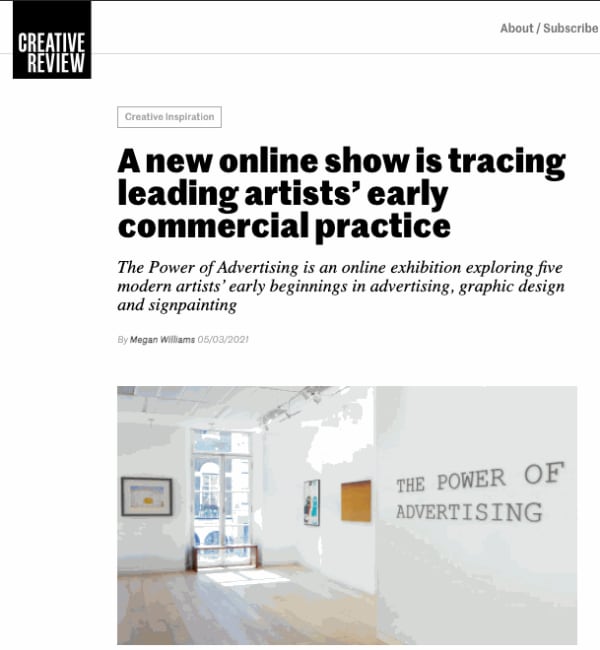The Power of Advertising: Online
Omer Tiroche Gallery is pleased to announce the forthcoming exhibition, The Power of Advertising, which examines the work of five leading modern artists who started their careers working in graphic design, sign painting or advertising. The exhibition aims to illustrate how the visual styles and tropes of advertising’s golden age became a key influence in modern art movements, including Surrealism and Pop Art.
Advertising first became a major societal force in the 1920s, just as Surrealism was becoming the predominant artistic style in Europe. Before gaining international success as a fine artist, René Magritte worked as a freelance graphic designer from 1924, producing advertisements for brands including Alfa Romeo. While he would start to exhibit his work in 1927, he never abandoned the commercial world. With his brother, Magritte established his own advertising agency, Studio Dongo, and continued to create posters, music covers and advertisements through the 1950s.
No artist was more aware of branding in art than Andy Warhol. Warhol famously started his career as a commercial illustrator, mainly drawing shoes for adverts in Vogue, Harper’s Bazar, and Glamour magazine in the 1940s. In his art, he continued to engage with advertising, reimagining and reproducing the imagery of everyday consumerism, once even commenting that “department stores are kind of like museums.” Later in his career, Warhol would turn from products to the symbols of currency itself, creating a series of dollar signs on canvas, the ultimate expression of Warhol’s lifetime infatuation with consumerism.
Similarly, Ed Ruscha’s initial training was also rooted in commercial arts as he studied lettering, design and advertising. During this period, he worked as a sign painter and typesetter and after graduating, he took a job as a layout artist at an advertising agency. Ruscha used these skills in his painting President, 1968-1972 by presenting a word imbued with the power of a brand, but he disrupts any easy recognition by setting the individual letters far apart. The tropes he learned in his early career continue to stay at the heart of his work, as he questions viewpoint, scale and form, placing emphasis jointly on both words and imagery.
James Rosenquist also had an early awareness of the power of signs; he started painting billboards in 1953 when he was still a teenager. During this formative period, he would paint billboards across the Midwest and in New York City, ultimately becoming the lead painter for Artkraft‐Strauss. The experience allowed him to hone in on his skill and develop a keen understanding of materials, but it would also influence his choice of subject as he sought to match the visual imagery of advertising.
We are attacked by radio and television and visual communication at such speed and with such force that painting seems very old fashioned …why shouldn’t it be done with that power and gusto [of advertising], with that impact. – James Rosenquist
At the beginning of his career, Sol LeWitt pursued his interest in design alongside his art practice; he studied at the Cartoonists and Illustrators School in New York and worked for Seventeen Magazine, making paste-ups and illustrations. In Rip Drawing (R27), March 1972, LeWitt had already turned away from the brash colours of the commercial arts, instead embarking on a series of Minimalist works constructed with subtle shifts of white and coloured paper. LeWitt intuitively developed an approach based on systems and serialisation that focused on ideas over execution, bringing him to the forefront of the Conceptual art movement.
The Power of Advertising reveals how, for these seminal artists, their initial experiences in commercial arts not only laid an invaluable foundation for their work but continued to resurface throughout their career. They perpetrated the bold styles and striking imagery of the sector in their work, resulting in the hallmarks of advertising embedding themselves into the modern art canon.
Featured Artists: Sol LeWitt | René Magritte | James Rosenquist | Ed Ruscha | Andy Warhol






